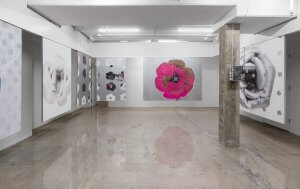Lorenza Longhi: World of Yum Yum | Émergent Magazine
Jun 05 2024

ART AS A FEAST OF CONTEMPLATION
“Commodities promise to lift and separate people from feelings of inadequacy and unloveliness, but they can also betray us, give us dirty looks, and make us feel unworthy of them.”
– Rhonda Lieberman, Artforum (1992)
“We live in capitalism, its power seems inescapable – but then, so did the divine right of kings. Any human power can be resisted and changed by human beings. Resistance and change often begin in art.”
– Ursula K. Le Guin, 2014
Lorenza Longhi is intent on devouring the more unappetising flavours that our society has a predilection for, with an odious relish, before serving it to us, as observers, not on a dinner plate but by spitting it back out through a course of realisation and contemplation. “It’s a reflection of what happens to me as a person,” she says during our meeting. “I can also observe it in some people around me where there is a certain attraction to consume and own certain things.”
In You’re in business? I’m in business, her 2019 solo show at Plymouth Rock in Zürich, Longhi raided “society for its deceptive structures, codes and verses,” as voiced by its accompanying text. “This supposedly neutral plunder,” it continues, “is remixed and duplicated, highlighting and complicating its primary form. Her work deals with the reproduction, but at a level that exposes its labour, craft and the worker’s hand.” Consider Cosmopolitan Haze at ChertLüdde in 2020-21, in which Longhi forces us to reflect on the contemporary, obsolete nature of the objects that we once lusted, even drooled, over before purchasing them in a frenzy of card swipes and pin insertions. Or The Olds at FANTA-MLN, Milan, in 2022, where projects whipped up from commercials, magazine inserts, wrappings, and design material, compelled us to be sentient in an oblivious bubble of irredeemable gluttony. Before the foray of Sentimental Pop at Weiss Falk in 2023. Its Andy Warhol resurrecting flower paintings made paradoxical by spy-camera centres showcased investigations into appropriation and mass production.
“I observe the strategies with which luxury stores, airports or public institutions are built or furnished. For me, the act of recreating them with found materials or DIY techniques is a way to demonstrate a second way of doing things,” she points out. “The fragility of the things that I can use interests me in the sense that they belong to the art universe, they’re not products that need to be consumed so they solely have to last as artworks. They’re not functional, so they can be extremely fragile, they are made to be long-lasting, but they are also subject to change with time, and they don’t need to respect certain quality standards. I find that there’s a power with fragility.”
As with every feast, dessert is obligatory. To portray Longhi’s World of Yum Yum as such, however, leaves a sour taste. Longhi’s solo exhibition at the Swiss Institute of Contemporary Art New York, her first solo exhibition in the US, considers spaces of display and the desires they engender. Apicius may have said that ‘we eat first with our eyes,’ yet it’s the central conversationalist of this piece who responds by saying that she continues to have a burgeoning, button-popping, zip-unfastening volume of room on her plate that’s otherwise overflowing with spontaneity and intentionality, putrescence and saccharinity.
Although, at the Swiss Institute, these items transformed into capitalistic objects that were prophetic; the Chanel imitating camellia flora in numerous circumstances, for instance, appeared to circumvent around the inclination of luxury standing as a corporal manifestation of our greed, of our desire for more, particularly as her interpretations of the bloom had been realised from once repudiated items. Something that, upon further introspection, only served to further ponder the fleeting nature of the sentimentality that we convey upon objects we perceive as being far more valuable than the discarded ones that came before, or even, after. “Prolong this inevitability as much as you may,” they seemed to say. “Everything you own over the years is consigned to a dark corner or junkyard where they are found and made contemporary once again, as we have been.”
“I don’t like to throw away, but at the same time I cannot encourage myself to own too much,” Lorenza admits. “Also from a practical point of view, I have changed studios many times over the past years, so I cannot hoard too many objects. Using these materials within my art is a way of enabling them to exist in a different form. They can be with me and yet not with me. I like to put them into another action.”
At the Swiss Institute, a symphony of pandemonium, lifted from sound recordings that had been taken by Lorenza over the course of visits to Zürich’s department stores, only served to make World of Yum Yum even more paradoxical. “World of Yum Yum provided an insight into everything we’ve discussed about how you place yourself as a viewer, as a consumer, as a buyer or seller,” Longhi reflects. “When I do an exhibition or craft a situation within four walls, I hope viewers can leave and have a slightly different understanding of how the space is constructed and offered to them. It’s giving a key to open a door.”
